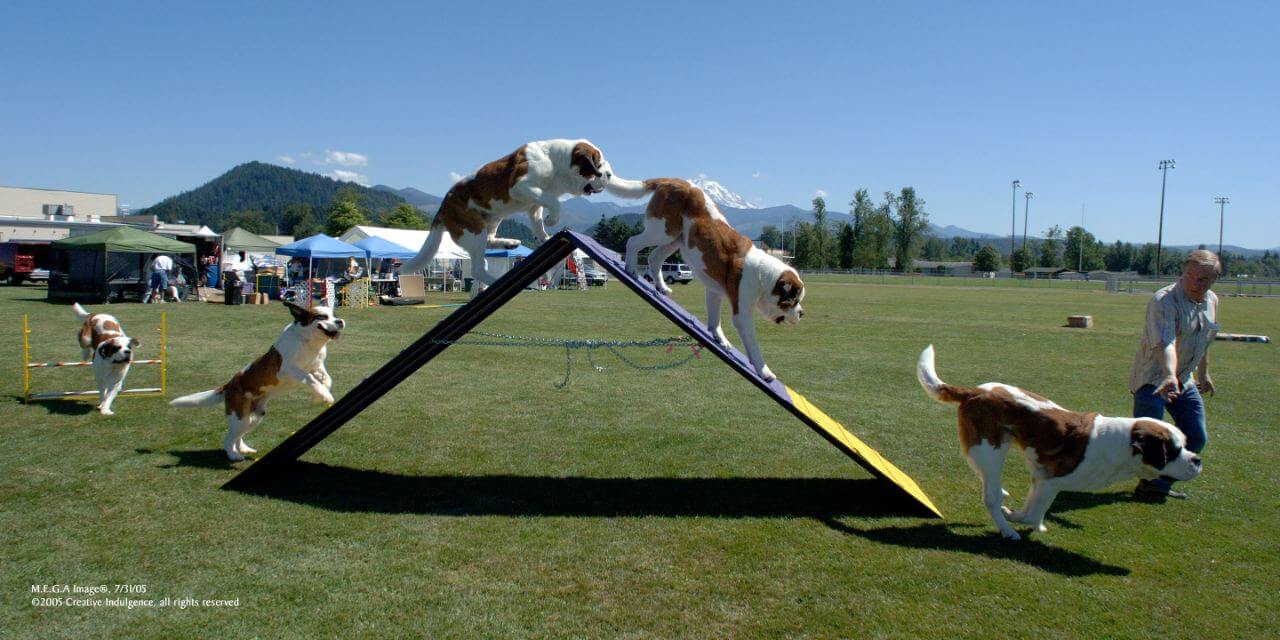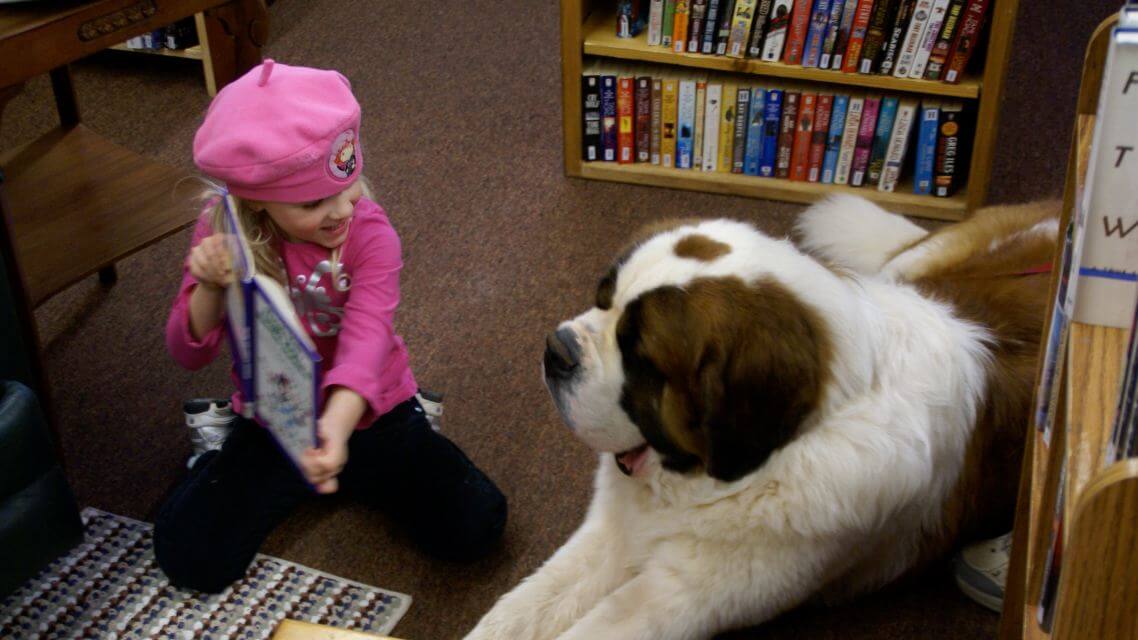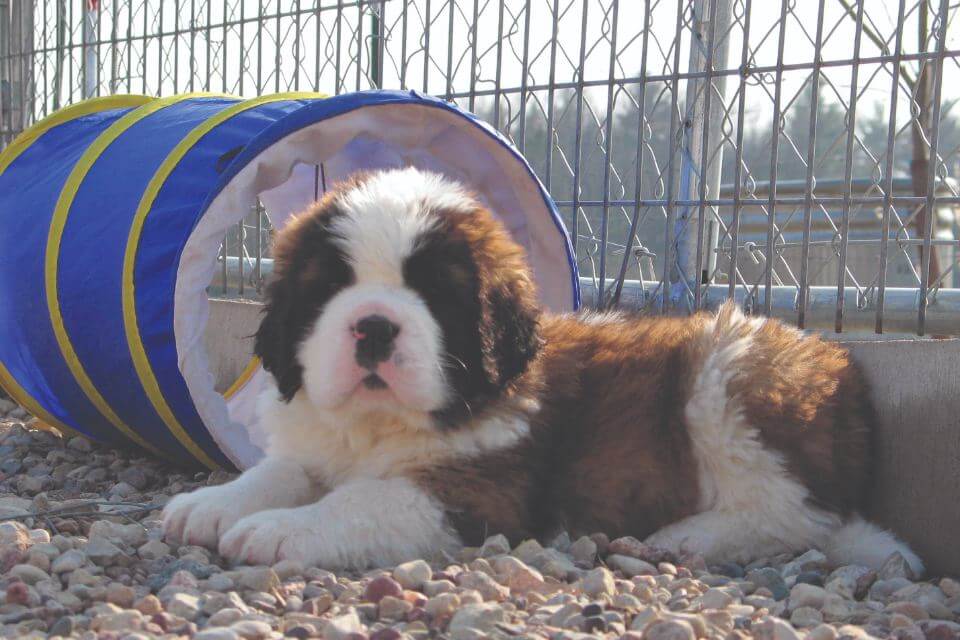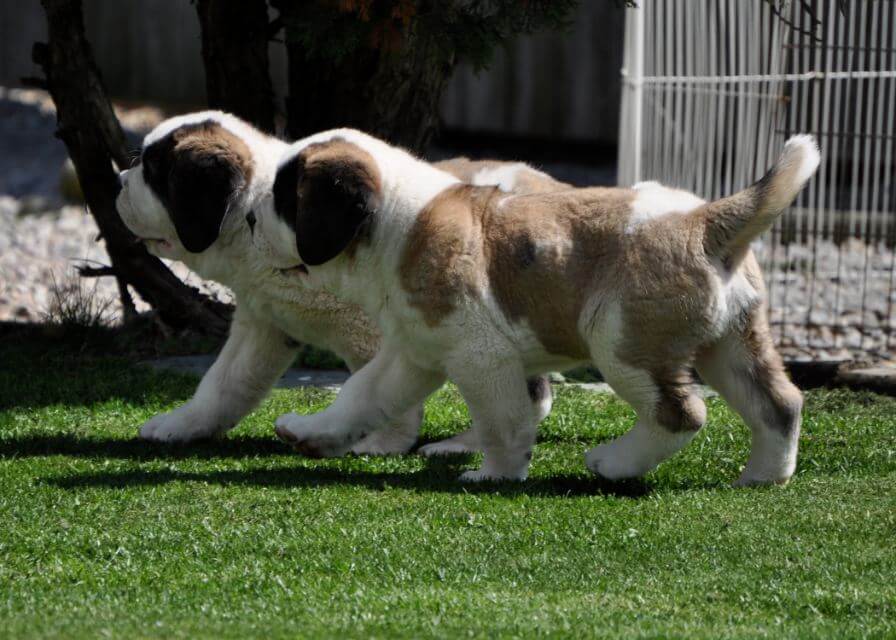


Home » The Saint Bernard

This article was originally published in Showsight Magazine, August 2013 issue.
The Saint Bernard has long been a faithful companion of mankind from unique life-saving work beginning in the 1700s to an outgoing unhurried temperament with great intelligence as a companion dog. Saint Bernards are powerful, proportionately tall, strong, and muscular in every way. The original Saint Bernard was a shorthaired dog, but both short and long-haired dogs are readily seen today. Dogs at the shoulder are 27½ inches minimum height, and bitches are 25½ inches according to the Approved AKC Standard. Dogs of today are usually much taller than the minimums. The Saint Bernard Club of America (SBCA) maintains that the only standard that correctly describes the original type is the Swiss Standard of 1884. Thus, the currently approved American Kennel Club standard differs only slightly from the original Swiss Standard. Saint Bernards serve faithfully today in many rewarding, fun, and challenging activities in which owners participate. The Saint Bernard is shown in Conformation, Obedience, Rally Obedience, Tracking, Weight Pull, Agility, Draft Test, Therapy Dog, and Canine Good Citizen.

Although the true origins of the Saint Bernard breed are not well documented, some aspects of this extraordinary breed are known. Authenticated facts combined with reasoned speculation are believed to best describe the development of this magnificent breed. The Monastery and Hospice were founded in 980 A.D. by Bernard de Menthon, an Augustine monk. These edifices were located in the only pass through the Alps between Italy and Switzerland. Being the site of heroic rescue tales, it was later named the Great Saint Bernard Pass to differentiate it from the Little Saint Bernard Pass that is between France and Italy. The altitude at the Great Saint Bernard Pass is a little more than 8,000 feet above sea level. Nothing was written about the hospice dogs during the first 700 years of their existence. Many stories surround the formation of the breed. The earliest known depiction of the breed was two paintings done in 1695. Some attribute these to the work of a well-known Italian artist named Salvatore Rosa. Each painting shows a well-built shorthaired dog with a typey head, a long tail, and dewclaws.
One dog is splash coated, while the other dog is mantle coated. One expert, Professor Albert Heim, concluded that these paintings show a breed that had been in existence for approximately 25 years. Thus, the most accepted estimate is that the breed originated sometime between 1660 and 1670. From the available written records, it seems that the unique lifesaving work of the dogs began about the year 1700. Before that time, it is assumed that these dogs served as watchdogs and companions to the monks during their winter periods of snowbound isolation. No written records clarify how the rescue tasks of these dogs evolved.

It appears that the dogs initially accompanied the monks on mountain patrols after bad snowstorms seeking unwary missing or trapped travelers. The dogs seemed to have an uncanny sense to detect impending avalanches; consequently, the monks wanted the dogs to accompany them while they traversed those perilous footpaths. Somehow the dogs learned rescue techniques from the monks. Eventually, male dogs were sent in unaccompanied packs of two or three to seek lost or injured pilgrims. (They thought this work was too arduous for the bitches.) Often the dogs had to find people buried in the snow, dig through the overlaying snow, rouse the traveler, and lie atop the wayfarer to provide warmth if the traveler was unable to move. Meanwhile, the other dog would return to the hospice to alert the monks that they needed to rescue a trapped pilgrim. Travelers who could still walk would be led back to the hospice by the dogs.
The instinct to dig people buried beneath snow and to rouse those lying in snow is still evident in the breed today. During the winters of 1816, 1817, and 1818, the snowstorms at the Great Saint Bernard Pass were especially severe, and many dogs perished while doing rescue work. As a result, the Saint Bernard strain living at the hospice came close to extinction. The records say that the monks completely replenished the strain two years later with similar animals from the nearby valleys. Rumors persisted that the remaining dogs were crossed with Great Danes or English Mastiffs after that near extinction, but no records exist to confirm that these breedings occurred at the hospice. Three experimental breedings with a Newfoundland type dog were done at the hospice beginning in 1830. Why were these cross-breedings made 160 years after the breed’s origin and after so many years of success using only the shorthaired dogs? Because many dogs perished during the more severe winters, the monks reasoned that the long hair of the Newfoundland would better protect the shorthaired Saint Bernard against the cold.

This idea was disastrous. Ice formed on the long hair during the lengthy circuits through the high snow, and the weight of the accumulated ice and snow very quickly incapacitated the dogs. Consequently, they could not use longhaired dogs for rescue work. Almost immediately, the monks returned to the exclusive use of shorthaired dogs for mountain work and began to give away all longhaired puppies. The Swiss recipients of these puppies used them for breeding with their own dogs, also resulting in litters containing both longhaired and shorthaired puppies. Selective breeding done by most dedicated Swiss fanciers resulted in the return to the original hospice type dog, with only the length of hair differentiating the shorthaired and longhaired varieties. During this time, the breed was still without a name. It was the much-traveled and dog-loving English who first recognized this outstanding breed of dog in Switzerland. They called them Hospice Dogs, Holy Dogs, Alpine Mastiffs, and Saint Bernard Mastiffs. Others called them Mountain Dogs, Monastery Dogs, or Swiss Alpine Dogs. Many Swiss called them Barry Dogs as a tribute to the famous hospice dog. Barry der Menschenretter was reputed to have saved more than forty travelers during his working lifetime. Finally, in 1880, it was agreed to call the hospice dogs Saint Bernards. The first record of planned breeding outside the hospice began in Switzerland in 1855 with the efforts of Heinrich Schumacher. He originated the first stud book for Saint Bernards and worked to maintain the original hospice type. Herr Schumacher and his like-minded friends bred to hospice dogs and supplied dogs to the hospice.

A high demand existed for these distinctive dogs, especially from the English. Many people uneducated to the original characteristics of the breed began breeding Saint Bernards throughout Switzerland, resulting in detriment to the breed. To preserve the original breed type, the Swiss Kennel Club was founded in 1883 and adopted the first Swiss Saint Bernard standard in 1884. There are now three Saint Bernard standards in the world; a modified old Swiss version still used in the United States, the English version, and a much-revised Swiss version adopted by all FCI countries in 1993.
The Saint Bernard’s temperament is outgoing and unhurried with great intelligence. What sometimes may be viewed as stubborn may actually be ingenuity. Saint Bernards believe they are in charge and enjoy family activities, particularly when they get tidbits for performance and cooperation. Saint Bernards love the morning sun before it gets too hot and need a fenced-in exercise area to develop proper muscles.
They are not good guard dogs, however. SBCA recommends asking several questions before making the decision to bring a Saint Bernard into your family. Are you accustomed to calm, even-tempered dogs? Will the Saint fit into your life expectations; they do not make good jogging dogs nor play with Frisbees. The dogs are extremely large-sized; can you enjoy meeting these needs? Can you enjoy regularly walking these large animals? Saints need both crate and house training early in their life before they grow so large; can you accommodate these training needs? Saints are not good guard dogs; is this acceptable even though they are large? Well-taken care of Saints live to be eight to twelve years old; are you willing to make a lifetime commitment? If the answer to these questions is yes, then a Saint Bernard may be the right dog for you. Exercise is needed to keep your dog fit and trim. Your dog will appreciate a daily walk even if he has a large yard in which to run and explore. Begin walking the dog slowly, gradually increasing the distance to increase your dog’s stamina. Regardless of whether your dog is indoors or outdoors, exercise is imperative. Ensuring your Saint gets enough exercise and interaction/play with you and your family will result in a healthy, happy companion. It is important to raise emotionally healthy puppies. Dogs go through developmental periods, and knowing these periods will help you know what training to do when. Socialization is desensitizing a dog to the things he will encounter in daily life by teaching him not to react.

It is imperative your pup is positively exposed to the various situations and environments that he may encounter throughout life. Know your pup and what his body language is telling you in order to know if he is being properly socialized or is being overwhelmed. Use treats to redirect your pup’s attention and, if needed, reintroduce him to the same situation in slower and smaller steps to build confidence. You can safely socialize your pup while protecting him from contagious diseases such as Parvo. Go to places where other dogs do not go, like shopping centers and friends’ homes. Get your puppy in a playgroup with other healthy vaccinated puppies as well as exposing him to healthy friendly adult dogs. It is up to you to ensure your Saint becomes a well-rounded, happy, integral part of your family through proper crate and house training, grooming, good nutrition, exercise, and socialization. It requires consistency, effort, and patience, to name a few, on your part but will be well worth it. It is your responsibility to ensure your new family member has the best life possible. Additional care, feeding, and training information are available on our website at www.saintbernardclub.org.
